

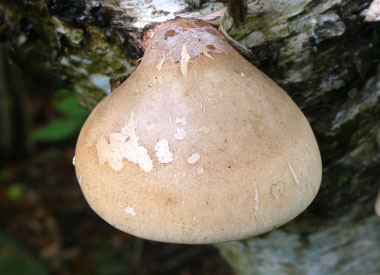
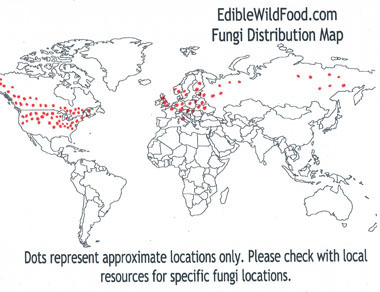
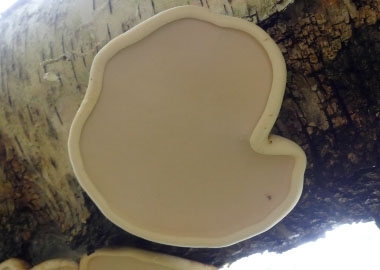
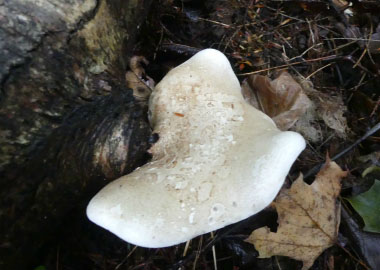
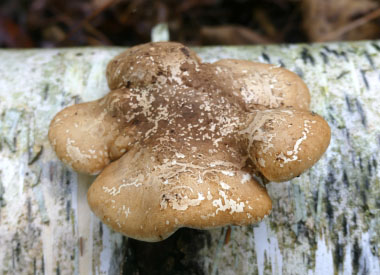
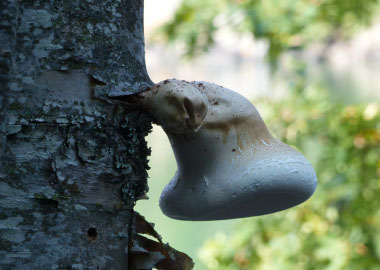
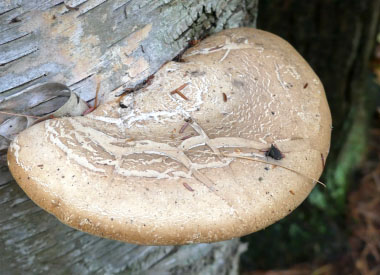
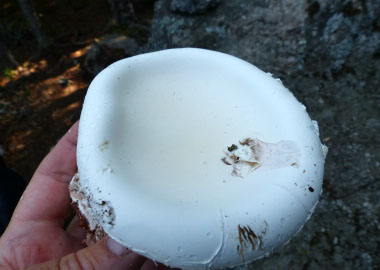

Do not eat any fungi that has not been properly identified by a qualified professional, some are DEADLY when ingested. All edible wild fungi MUST be cooked.
Fomitopsis betulina (previously Piptoporus betulinus) is commonly found in countries around the world that have birch forests. This edible and medicial polypore has been extensively studied and there is ample evidence supporting the antibacterial, anti-parasitic, antiviral, anti-inflammatory, anticancer, neuroprotective, and immunomodulating activities. Birch polypores are a common basidiomycota brown rot macrofungus that grows on decaying birch trees. By the time the white fruiting body emerges, decay to the tree is extensive. In 1753 Carl Linnaeus first described this fungus and referred to it as Boletus suberosus, and later the French mycologist Jean Baptiste Francois (Pierre) Bulliard changed the specific epithet to betulinus - a reference to the birch trees (Betula spp.). In 1821, Bulliard transferred this very common and widespread polypore to the genus Polyporus, where it remained for sixty years. In 1881, Finnish mycologist Petter Adolf Karsten transferred the birch polypore to a new genus, Piptoporus, which he had created.
Type
Distinguishing Features
Birch polypores have white-to-brownish fruiting bodies. They are annual, emerging from the bark of dead or dying birches in spring and summer. They deteriorate slowly and persist through the winter; although when they are brown or blackened they are no longer useful. Most fungal conks are woody and hard, but birch polypores have a soft, leathery feel and an inflated look. They are attached to the tree by short, fat stalks. The smooth upper surface folds over at the outside edges, leaving a rounded rim around the flattened lower surface. They start as a subglobose then forming a 'hoof' shape finally becoming an enlarged flat bracket.
Height
On average these polypores reach 6cm (3”) high and 30cm (12”) wide.
Habitat
Birch polypores are almost exclusively restricted to dead or dying birch trees. The brackets are annual but may persist through one winter. They can be found throughout northern Europe, Canada, Asia, and in several states throughout the U.S.
Spore Print
White.
Season
Although these bracket fungi persisting throughout the year, they are annuals and release spores in late summer and autumn.
Gills
This is a polypore so there are no gills. They have small white tubes that are packed together at a density of 3 or 4 per mm; they measure between 1.5 and 5mm deep and terminate in white pores that brown as they age.
Edibility
Birch polypores are not known as being a culinary fungi however it can be used in a variety of ways. Young polypores can be sliced thin, marinated then roasted. Cut up and dried, they can be used as a tea although it isn't that great tasting. Dehydrating is a great way to preserve them long term (although exactly how long is not known). Once dehydrated they can be powdered, then add to any dish you prepare. Store in a cool, dark location once dehydrated.
Other Name
Birch Bracket.
Recipes
To support our efforts please browse our store (books with medicinal info, etc.).
Winter Survival Food Handbook

PDF Plant Magazines
Types of Wild Food
Geographic Zones Seasons
Disclaimer
EdibleWildFood.com is informational in nature. While we strive to be 100% accurate, it is solely up to the reader to ensure proper plant identification. Some wild plants are poisonous or can have serious adverse health effects.
We are not health professionals, medical doctors, nor are we nutritionists. It is up to the reader to verify nutritional information and health benefits with qualified professionals for all edible plants listed in this web site. Please click here for more information.
Why Edible Wild Food?
- Food costs are rising
- Free, wild food is readily abundant
- Wild food adds nutrition to your diet
- Wild food can help treat various medical conditions





